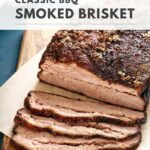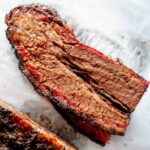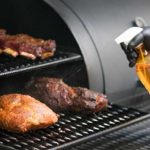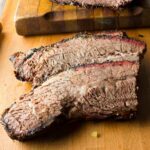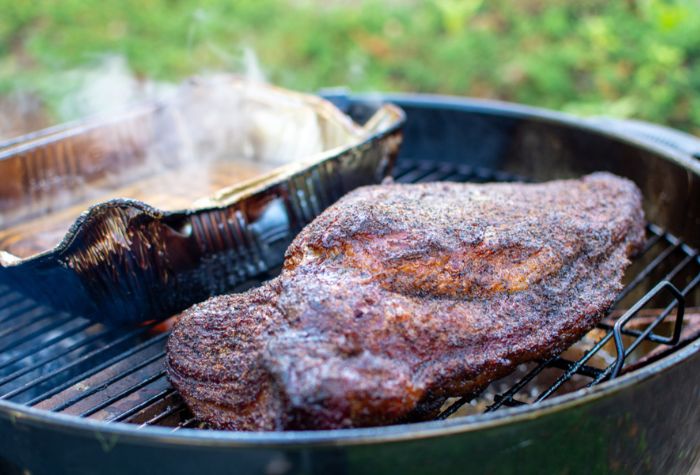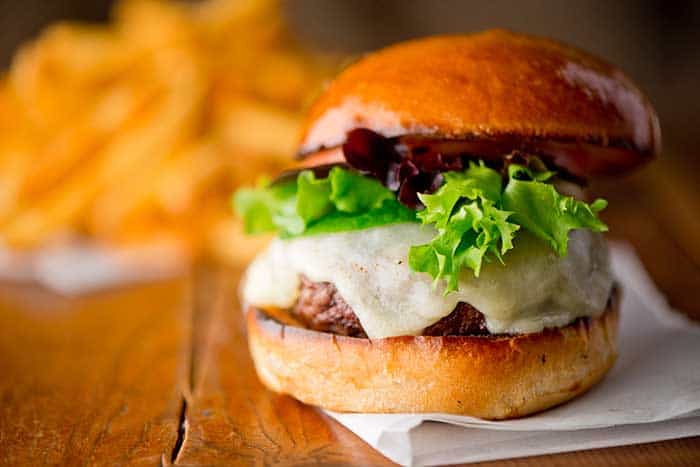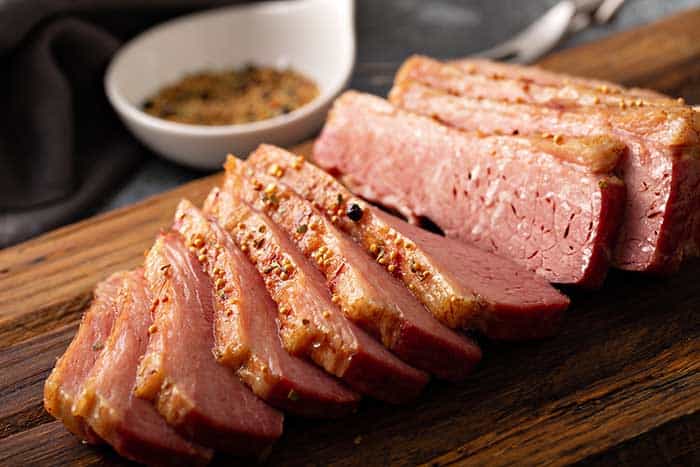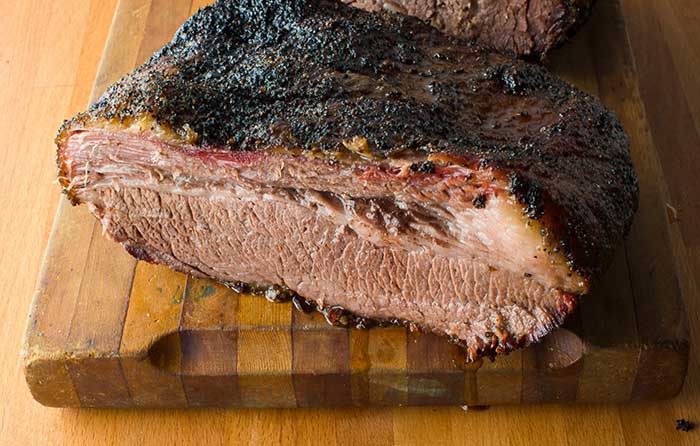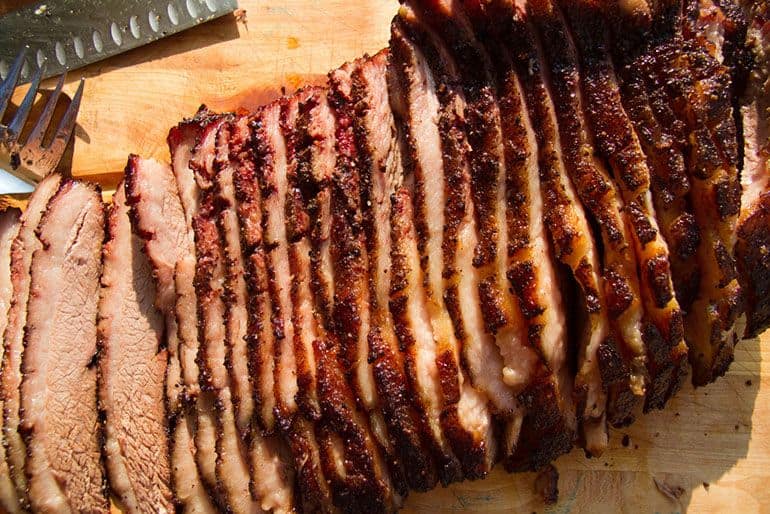Want to cook one of the barbecue world’s most iconic meats? Get ready for the perfect cut of beef with our beautiful and traditional smoked brisket recipe.
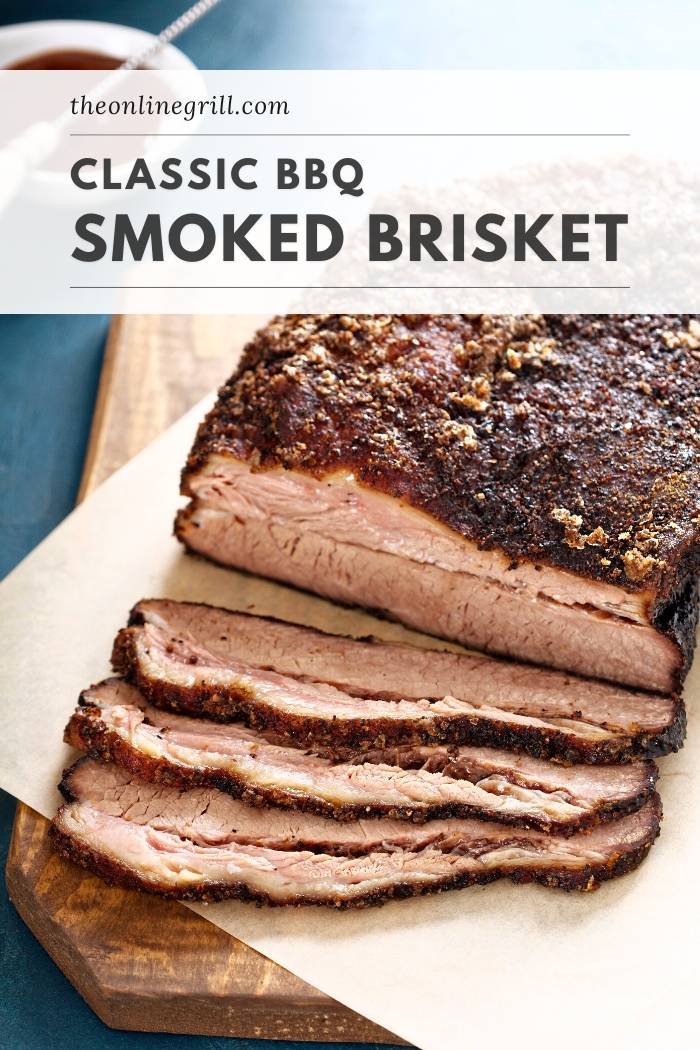
Smoked meat can be a challenge for anyone new to the cooking form. It’s not so much a recipe where you can throw together a bunch of ingredients, but rather a process.
So many factors come together to cook the perfect brisket, from your choice of wood for smoking brisket, or the brine you use. Every single one of these choices comes together to help make or break your brisket.
Today I’m going to walk you through everything you need to know, and the step-by-step guide you should follow to cook the best smoked brisket out there.
Note: If you have an electric smoker than the process is a little different so be sure to check out my guide on how to smoke brisket in an electric smoker.
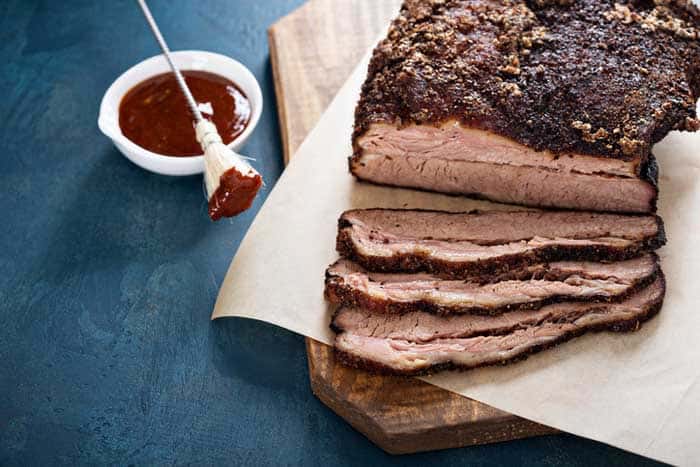
One of the best things about smoked meat is that you don’t actually need that many ingredients to pull it all together.
No sauces, no fancy garnishes. Just good old fashioned salt, pepper and smoke.
Oh and time.
Smoking brisket can be really intimidating the first time you do it. Good brisket isn’t easy or cheap to come by, so the thought of getting it wrong and all that good meat going to wast can be daunting prospect.
Once you have this process down however, you needn’t worry. Follow this guide and you’ll get near perfect results every time.
Your brisket will turn out juicy, smokey, and downright delicious.
What do you need to smoke brisket?
Luckily when it comes to smoking brisket, you don’t need too many ingredients. There are a few key tools you will need to make sure you have in place before attempting this recipe though.
A smoker
This much might seem obvious, but it’s probably worth mentioning regardless. Smokers largely fall into two categories: Electric or Offset/Charcoal.
Purists always go for offset because they can conjure up that iconic charcoal smoke that we all associate with BBQ. Electric smokers are far easier to use and start up however, and perhaps best suited for more casual BBQ fans and newcomers.
In truth, all that matters is that the smoker can maintain a temperature of 225°F.
Meat thermometer
BBQ smoking is all about maintaining consistent temperatures until your meat reaches its target internal temperature. The best way to do this is to use a good meat thermometer. The best kinds tend to be digital and need to be as accurate as possible (obviously).
I recommend something like the Thermopro TP-07 because it has a probe for monitoring meat, and another for monitoring grill and smoker surface temperature. It’s also incredibly accurate. You can get it here.
A good chef’s knife
Brisket can be very tough to cut both before and after smoking. Whether you’re removing the membrane from the top, or slicing it against the grain, you can experience a lot of resistance. So you need something that’s up to the job. Check out my guide to brisket knives here.
I have a Dalstrong knife. It’s made of German steel and has always been up to the job when I’ve used it. You can check it out here.
A cutting board
Brisket is a big slab of meat and you’ll need something large enough to prepare it on, and then rest it on after you have cooked it. Even if you have a cutting board for meat right now, I’d recommend measuring it to make sure it’s big enough to host a cut of brisket.

How to pick the best brisket
When choosing a brisket, the most important thing to remember is to get the brisket whole. You don’t want the point separate from the flat (sometimes called the first cut). A lot of butchers or supermarkets only seem to sell the first cut, but actually the best part of the brisket is the point. It contains a lot of the marbling and fat content, which is exactly what we want for smoking because it helps infuse the entire flesh of the meat with flavor.
In contrast, the flat is a lot leaner and therefore thinner in terms of fat content.
When it comes to deciding the quantity of meat you want, try to aim for about half a pound of brisket per person you are cooking for.
How to trim brisket
For a full guide, read my post on how to cut brisket.
While some people claim they don’t trim brisket, it’s important to remove components like fat and excess fat in order to prevent the meat from becoming a rubbery mess.

You will need to trim it prior to smoking, and then slice it afterwards. For initial trimming you need to take off the large fat cap that sits on top of the brisket.
There’s a little bit of debate here in the BBQ world about what to do with the fat cap here. Personally, I like to trim it to down to about an inch thick, but some people prefer the Aaron Franklin method, which is to leave it mostly intact.
You will then need to trim off excess fat, particularly any fat that sits between the point and the flat. This fat can effectively act as a barrier between the two, which will prevent juices flowing between the two when they cook. Removing this fat will help make your brisket far juicer and more delicious.
Skipping ahead slightly, you will also need to slice your brisket after it’s cooked. Allow it to rest when out the smoker for at least 30 minutes to allow the juices to permeate the meat more.
For maximum tenderness, slice against the grain. The challenge here is to do slice against the grain for both the point and the flat. The grain directions for each of these parts are opposite, so you will have to slice them separately.
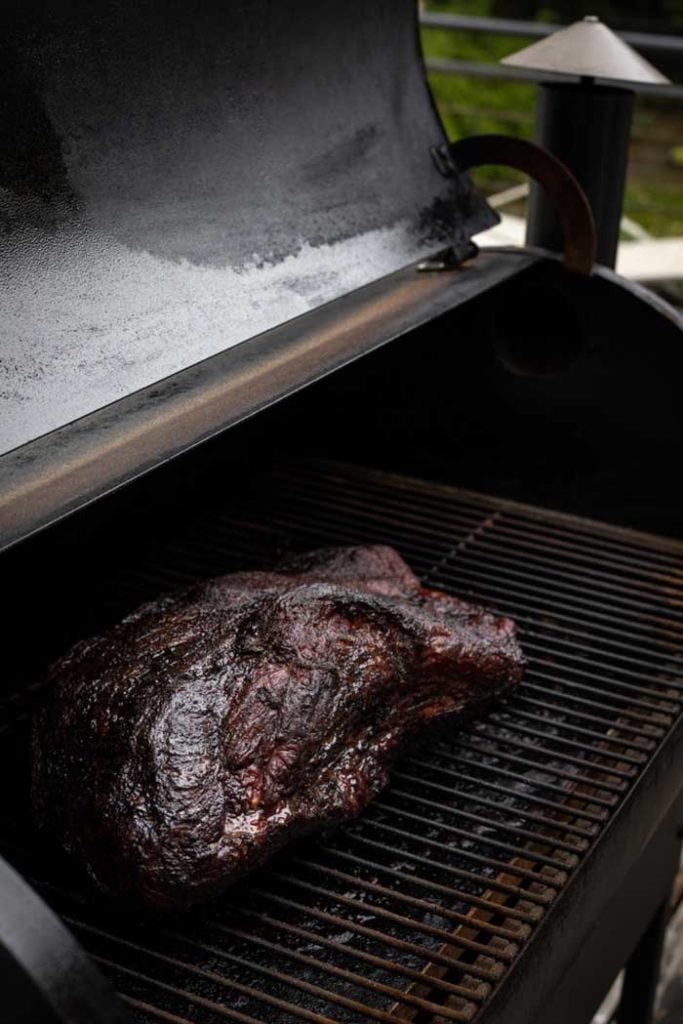
How to season brisket
I love to season my meat prior to smoking, and I love to season it generously.
This is where smoked meat comes to it own. I recommend just using coarse salt and black pepper. Apply generous all over the surface of your meat, and try to rub them in as thoroughly as possible.
Want something with a bit more kick? Check out my guide to the best store bought brisket rubs.
Some people add garlic powder. I personally don’t, just because I like my wood chips to do a lot of the work when flavoring the brisket.
If this is your first time, I’d stay away from anything beyond salt and pepper just to help you get a sense of how brisket can taste out the smoker. If you feel it’s lacking anything then you can try other seasonings and start to experiment.
What wood chips are best for brisket?
Read my full guide to the best wood for smoking brisket
The best way to infuse your brisket with added flavor is with good use of wood chips. They help create a better cooking environment in your smoker’s chamber, but also carry specific aromas and flavors to help enhance your meat even further.
Quite often choice of wood chips comes own to personal taste, but in the case of a heavier, red meat like brisket, the best wood chips are pretty irrefutable.
I always recommend going for ‘darker’ flavored woods like oak, hickory or mesquite.
Some people like to use slightly sweeter woods like maple or pecan, but as a starting point I’d always recommend starting with something more neautral like oak, and then later experiment with sweeter or fruit-based chips.
How long to smoke brisket
There isn’t really a hard and set rule for brisket smoking length, and the best rule to always go by is internal temperature.
The reason for this is that meat cut sizes invariably change, so what works for one cut won’t necessarily work for another.
As a general rule, brisket takes about 90 minutes to cook per pound of meat when cooked at 225°F. However it can’t really be considered as ‘done’ until its internal temperature reaches about 195°F.
This is why it’s crucial that you get a good meat thermometer.
The key is to allow a lot of time, because in most cases it’s not unusual to be cooking for anywhere between eight and twelve hours.
Other best smoked brisket tips
Use the Texas Crutch
The Texas Crutch is a method used by many competition-level pitmasters to ensure that their smoked brisket is juicy and moist fresh off the smoker. When done right, it can also help to speed up cooking time, as well as push your meat through the dreaded ‘BBQ Stall‘. Check out our full guide to the Texas Crutch to find out more.
Don’t forget to allow it to rest
This is more important than you might think (source). After it’s cooked, wrap the brisket and leave it to rest on your cutting board. This will allow the juices in the meat to settle and redistribute while not allowing the temperature of the meat itself to cool too much. I recommend allowing to rest between 30 and 60 minutes.
Mix your seasonings
To help make sure that my brisket is seasoned evenly, I like to mix my salt and pepper together first before applying it to the meat.
I have an empty salt shaker that I pour both into, and then shake it thoroughly. I then apply it to the beef. This also works if you’re using other seasonings, like garlic powder.
Cook fat side down
Fat content makes all the difference when smoking but, contrary to popular belief, the fat cap on brisket doesn’t add moisture to the meat. For the best results, place your brisket on the grates fat side down.
Positioning it fat side up will wash away any seasoning or rub you’ve used, and hinder your chances of developing a beautiful bark on the beef surface.
Place it fat side down will keep seasoning in place, provide a good consistecny of moisture and juice throughout, and also act as a shield against any hot spots or direct exposure to heat.
Don’t forget your sides
With such a big cut of meat, it’s easy to forget about what to serve it with. You can get creative here, and there are plenty of good sides for brisket that go far beyond just a side salad. Try grilled potato skins or smoked and cheese, or keep things simple with some grilled asparagus or corn on the cob.
Don’t worry about leftovers
Brisket is a big cut of meat, so it’s likely that you’ll be left with some to spare at the end of your meal.
Store it in your refrigerator in an airtight container, and pour any remaining juices over it to help preserve its moisture. You can then reheat it and make some of our creative recipes for leftover brisket.
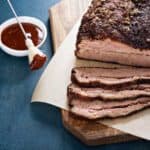
Smoked Brisket [Best Barbecue Beef Recipe]
Equipment
- hickory smoking wood
- digital meat thermometer
Ingredients
- 12 lbs whole beef brisket
- 2 tbsp kosher salt
- 2 tbsp ground black pepper
Instructions
- Fire up your smoker to 225°F (107°C). Be sure to set your smoker up for indirect heat.
Trim
- Place the brisket on a large cutting board and position it so the flat is on top
- Remove any silver skin or excess fat from the flat muscle. Trim until the fat is smooth between fat and point.
- Trim excess fat from the point. Trim the ends of the flat to form a square-like shape.
- Turn the brisket over and trim the fat cap to approximately ½-inch thick across the brisket surface
Season
- Apply kosher salt and black pepper seasoning generously across the brisket, covering all sides evenly
Smoke
- Once smoker is at 225°F, add your hickory wood chips to coals or wood tray
- Place brisket on smoker, fat-side up. Close the lid and smoke until the meat internal temperature reaches 150°F (65°C)
- (Optional) Remove brisket from smoker and arrange on aluminum foil sheet (or butcher paper). Tightly wrap foil around around brisket. Double wrap to ensure the foil is as airtight as possible.
- Place brisket back in smoker and increase cooking temperature to 250°F (120°C). Smoke until meat internal temperature is 195°F (90°C).
- Remove your brisket from the smoker and wrap in towel or extra foil. Leave to rest for 60 minutes on a large cutting board.
- Remove brisket from foil and slice against the grain to serve. Pay attention to contrasting grain direction in point and flat.
FAQ
Got any burning questions about barbecue brisket? Our frequently asked questions are here to help.
Why did my smoked brisket turn out tough?
- Collagen. You would think that with a large amount of fat in the brisket, drying out should be the least of your worries. However, it can become tough because of the connective tissue it has. This is also called collagen.
- How you cook it. When brisket is cooked fast, it can turn out tough. You need to cook it slowly. The collagen melts gradually to form a gelatinous substance that will give you a tenderized texture when you do this. You can get an even better result by using some form of liquid, such as a juicy marinade.
- The cut. You need to choose the right cut from the onset. If the brisket doesn’t have enough fat marbling, it will easily dry out.
How long should I let my brisket rest?
Allowing your brisket to rest sufficiently is key in cooking tender, juicy beef. To ensure that you do not lose out on too much when you cut into the meat, let it rest for up to 40 minutes. At this time, the meat will still have the right internal temperature for a good meal.
Should I add liquid to foil when wrapping brisket?
Yes, if you don’t mind disintegrating the bark. Adding a liquid inside the foil when you wrap the brisket helps add to the moisture and complements the flavors that already exist in the meat. This works if you will be using the pan method to wrap the meat. In this instance, you add whatever liquid you feel will add the flavor you want to the piece of meat.
It is important to note that juices will seep out of the meat when you wrap the brisket during the process—as such, adding extra liquid could lead to excess moisture, which can also lead to a soggy brisket.
What should I spritz it with?
Using a good brisket spritz can help keep the beef moist and tender, while preventing the bark from overcooking. You can use apple cider vinegar, lemon juice, Worcestershire sauce, apple juice, or even plain water. You may also choose to use a beef stock with a bit of vinegar added to it. Some also add beer to the mix for a different flavor.
